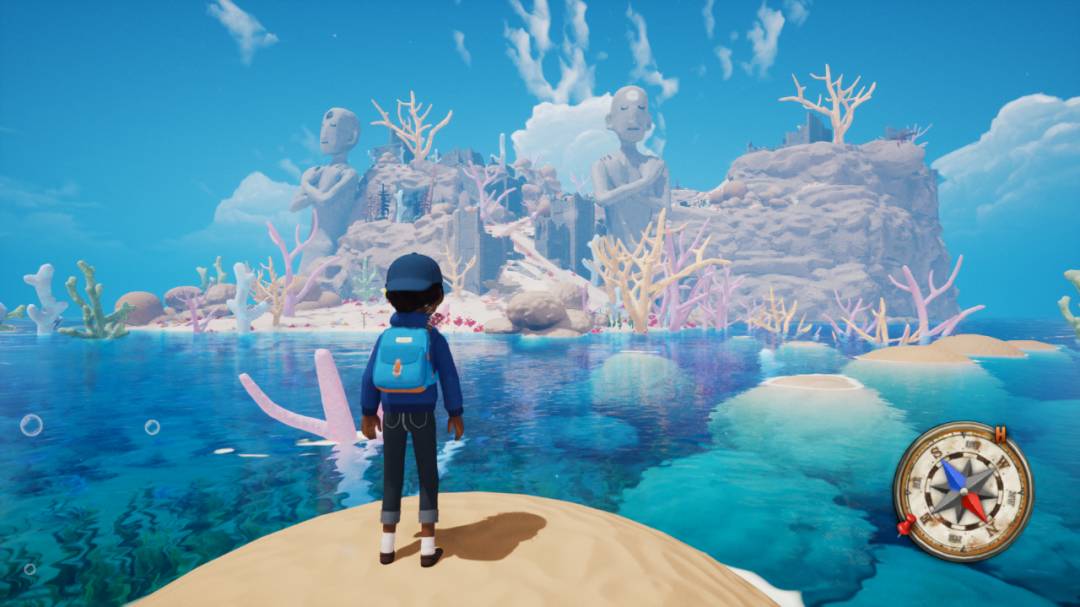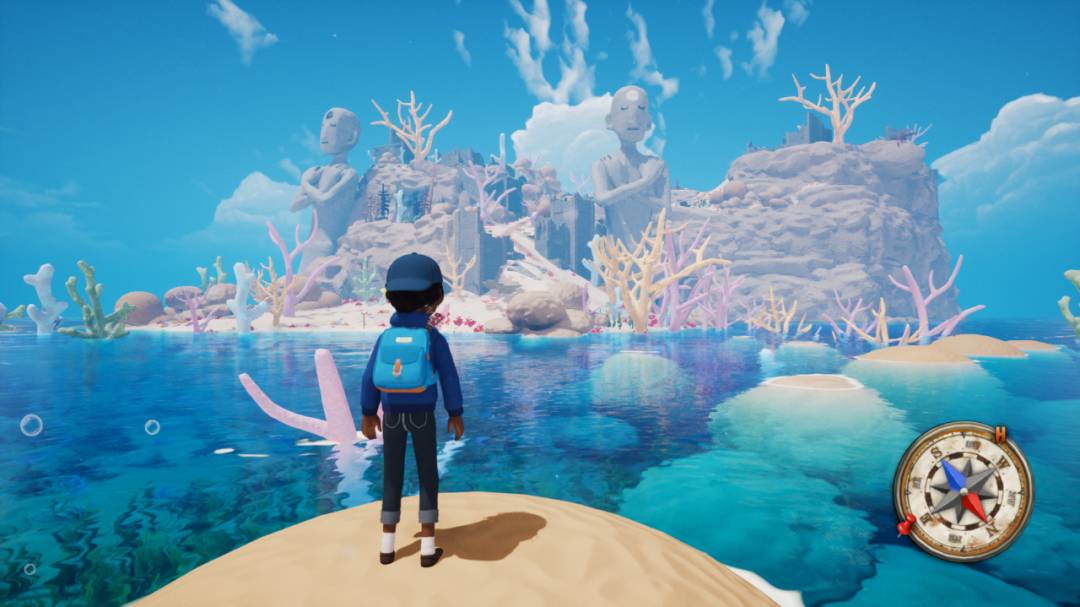Tchia: A Unique Open-World Action-Adventure Game Explained
Debuting on March 21, 2023, Tchia is an open-world, third-person action-adventure masterpiece crafted by Awaceb, a 12-person independent game studio based in Montreal, Canada, and published by Kepler Interactive.

Image Source: Sourced from the Internet
The idea for the game was inspired by the small island of New Caledonia in the Pacific Ocean, the home of the game's two founders. In the game, players will take control of the character of Chia as she explores a fictional archipelago based on New Caledonia.
Utilizing Kia's amazing shapeshifting abilities to fight against the Ragged Soldiers created by the Tyrant, the player will try to save his father from the Tyrant (whose archetype is derived from local legend) who rules the islands. Along the way, players will make new friends and enjoy the mesmerizing scenery.

Image Source: Sourced from the Internet
As the developer team's message says, the game is a love letter to their homeland. Using audiovisual interaction as a unique tool, they have blended the landscapes, culture, music, language and folklore of New Caledonia to create a relaxing island adventure.
The game itself has not only had a profound impact on New Caledonia, allowing more players around the world to enjoy the unique culture of the region, but has also fully demonstrated the important role of games as a medium for showcasing the diversity of world civilizations. It is for this reason that “Kia” successfully won the “Most Influential Game” award at TGA2023 and the Most Connotation Award at the BAFTA2024 game awards, which is really well deserved.
I. Key Points of Emotional Interaction Design
(I) Definition of Emotional Interaction Design
When it comes to emotional interaction design, we have to think of “Emotional Design” by Donald Arthur Norman. Norman believes that emotional design is a design idea that takes the user's emotions and feelings as the starting point. Interaction design means that designers are committed to creating and constructing meaningful relationships between people and products and services, analyzing both user experience and usability, and paying great attention to human-centered user needs. Therefore, Emotional Interaction Design is a design concept that emphasizes on meeting the emotional needs of users, and it perfectly integrates emotional elements with interaction design, which can trigger strong emotional resonance of users. By adding emotional elements to the product, users can get pleasure and comfort when using the product.

Image Source: Sourced from the Internet
(ii) Emotional interaction design in games
Emotional interaction design in games also follows this concept, which, on the basis of the principles of interaction design, makes the interaction highly compatible with the game context, so that players can further immerse themselves in the audio-visual interactions and narrative content of the game, and thus obtain a smoother emotional experience.
(III) Emotional interaction design idea
The uniqueness of the emotional interaction design of Qiya is that it pays more attention to the continuation of players' emotional experience, so that players can better understand the island culture depicted in the game.
The game firstly provides players with a good environment for generating emotions by creating immersive audition interactions; then it starts from operation guidance to minimize the possibility of players getting out of the state of heart flow; and finally, it simplifies the interaction process to guarantee the continuation of players' emotional experience, which helps players better understand the island culture presented by the game. Next, we will analyze the emotional interaction design ideas of “Kia” in detail from the above three aspects.

Image Source: Sourced from the Internet
Creating immersive audio-visual interaction
(I) Substrate: Strengthening and weakening of interface information
1. Strengthening key information: human beings receive 40 billion sensory information inputs per second, while our brain can only process 40 bits. Therefore, emotional interaction design on the one hand needs to highlight key information within the game from the behavioral layer of emotional design, such as audio-visual, in order to allow players to quickly access key information from the game. For example, in the game, when the player uses the Soul Jump skill, the interface will change to a warm grayish-white color, and the item that can be selected for attachment will be covered by a yellowish-green color with transparency, and when the mouse moves to the selected item, the item will switch to a white self-luminous state, with the edges of the item highlighted in green. This strong contrast in brightness and color allows players to quickly identify interactable and non-interactable items.
2. Simplify interface information: On the other hand, it is necessary to weaken the game interface information to create a more comfortable immersion base for players. In Kia, players can choose to switch to an immersive interface for exploration, in which they will only see relevant UI prompts when they encounter interactable items or achieve quest objectives. In this way, players can better experience the local culture during immersive exploration.
(ii) Medium: Perspective Switching and Interaction Feedback
1. Immersive perspective switching: In the game, players can possess different animals and objects, such as seagulls, chickens, dogs, trophies, toys, etc. through soul jumping and continue their adventure in the map from a third-person perspective. When possessing some of the creatures, they can also use their unique interactive actions, such as cats being able to see at night, boars being able to dig, chickens being able to lay eggs, and so on. Players can greatly enhance the fun and immersion brought by the skill of soul jumping by using the character interaction actions associated with the third perspective while switching to the third perspective.
2. Rich scene interaction feedback: Most of the things in the game scene can give feedback to the player's behavior, emphasizing the physical role, making the game have realistic logic and reducing the player's understanding cost. At the same time, it gives players rich dynamic feedback, which enhances the vividness of the game and the sense of interaction.
3. **Sound and color echo**: The characters of “Kia” are dubbed by locals in French and Derehou (the most popular language in New Caledonia). The player is able to explore the game's scenarios to discover famous local places, gastronomy and biota, as well as to play the game's instruments or listen directly to original compositions influenced by local music and performed by traditional musicians and singers. These audio-visual interactions give “Kia” a strong humanistic flavor and a unique audio-visual experience that intertwines tradition and freedom, deeply involving the player's mind and heart in the island culture of New Caledonia.

Image Source: Sourced from the Internet
Third, the clever use of operating tips
(A) Character Performance + UI Operation Tips
In the game, the producer adopts the combination of character performance and UI operation hints to guide the teaching, and “gives” the teaching task to the NPCs who are communicating with the player in the game context, which reduces the possibility of the player getting out of the communication experience and enhances the sense of immersion. For example, when the player learns the interactive action of bird's eye view, he is first taught by the father of the protagonist through a character performance animation, then the player learns the action during the performance animation according to the UI tips of the action buttons, and when the animation is finished and switched back to the game interface, the loading interface displays the operation tips of the action that has just been learned, and the loading time is decided by the player. This approach allows players to vividly understand the use of the action scene, while the emotional connection between the player and other characters can further increase the motivation to learn the action.
(ii) Highly relevant operation tips
Reducing the number of hints in the same interface and displaying only highly relevant operation hints can help players quickly find the information they need. For example, in Pile Stones Challenge, the tips related to the current operation will be displayed in the lower left corner of the interface, showing the tips of the operation buttons related to the current challenge content. This greatly reduces the memory cost of the player, reduces the probability of the player getting stuck due to operational reasons and causing the heart flow to stop, and ensures the continuation of the player's emotions in the game.
(iii) Scattered tips in line with the game context
In the game, the producer presents some fragmented task hints as things within the game context. These hints are built on the basis of realistic logic, and at the same time combined with the game worldview, minimizing the possibility of reducing the player's sense of immersion. For example, when the player is walking in a sparsely populated area, he may encounter a passing NPC, and by talking to him, he can get information about the surrounding area, quests, or a short story about the NPC himself. This NPC-style tips are in line with the game context, but also to a certain extent to avoid players to lose their way, reduce the boredom of the players due to the long time in the field to explore the fruitless, and even let players look forward to the next encounter with the mysterious passer-by.

Image Source: Sourced from the Internet
Fourth, simplify the process to continue the emotional progression
(A) Automatic operation
In order to ensure that the player's emotional experience is not interrupted by the threshold of operation, the game provides the option of automatic operation. For example, when the player plays the ukulele and other instruments in the plot, he can choose to play the music manually or automatically. This interactive design of automatic operation facilitates some players to directly watch the animated performance during the playing and listen to the music with great local characteristics, so that players will not be lagged by the rapid operation requirements, which further enables the emotions during the game to be progressed and sublimated in the music.
(ii) Free choice of game mode
The free choice of interaction in the game empowers the player to play the game according to their personal preferences and improves the smoothness of the player's experience of the game. In Kia, there is no mandatory plot viewing, so players can independently choose whether to skip the plot and enter the adventure phase to explore the island; when stuck, they can also independently choose whether to skip the game phase and enter the next plot directly, or browse through the plot chapter summaries and freely choose chapters to experience. This freedom of choice allows players with different preferences to change the game mode according to their own needs, thus enhancing their own emotional experience.
V. Summary
With the continuous development of technology and media, the emotional interaction design of games has been increasingly emphasized as the emotional bond between players and game content. Excellent emotional interaction design eliminates as many interfering factors as possible on the basis of establishing the ease of use and usability of game interactions, guaranteeing players a smooth emotional experience when experiencing the game. The emotional interaction design of Kia is a worthy example.
By creating immersive audio-visual interactions and skillfully utilizing interesting operation guidance, it reduces players' learning costs as much as possible and enhances the sense of game immersion. At the same time, by simplifying the operation process and providing free choice of game modes, it creates a favorable environment for the continuation and sublimation of players' emotions. These meticulous and emotional interaction designs are interconnected, and together they create its island adventure game experience with a strong cultural flavor.
-------- END --------






